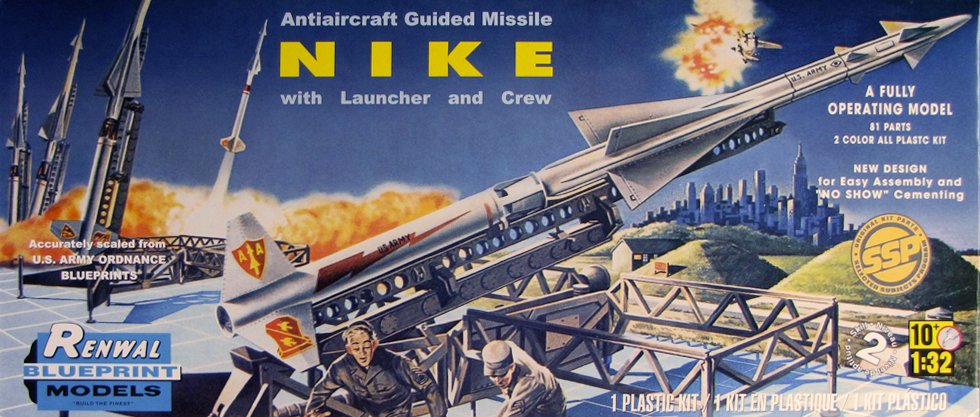Nike with Launcher and Crew
I am sucker for old kits. While I don’t collect vintage kits, I certainly relish every new special release from Revell. I was very happy to see that the Nike Missile got the green light for a re-release. The missile depicted in this kit is, in fact, the Nike Ajax. First fielded in 1954, it was a two-stage, supersonic anti-aircraft missile with a range of 25-30 miles and a ceiling of 65,000 ft. It remained in service until 1964 in the continental US and was superseded by the Nike Hercules, a much more robust and capable missile.
Since this kit is part of Revell’s selected subjects program, I can only assume that the parts come from the original molds, though the date on one of the pieces is 1983. Unlike modern kits that have individual sprues wrapped in plastic and padding, for this kit, there are just two plastic bags – one that holds the parts of the missile and the other the launcher and figures. Expect many of them to have separated from the thick sprue. According to the box top, the parts were molded in Poland. The plastic seems rather soft, so care must be taken when cleaning the flash off of the parts. It also comes with three figures, but given how ugly they are, I have not finished them. There is one set of markings.
Assembly
As with any older, re-released kit, there is flash that has to be taken care of as you go through the various steps of assembly. The first step is the launcher. While not a shake-and-bake kit, assembly is pretty straightforward. As mentioned earlier, because of the age of the kit, there’s flash on many of the components, as well as prominent mold lines. There are several subassemblies, the first being the launcher arm and its supporting girders, followed by the outriggers, and topping it off with the second half of the launcher arm. I didn’t encounter any issues in assembling the various components together. If you look at the box art, the missiles in the background are in a nearly vertical position. The launcher, as configured, will not go in a straight vertical position. My suggestion is to glue the arm at its highest angle to prevent gravity from taking its toll. For the purpose of this review, I used a small plastic shim made from some old sprue to keep the launcher arm up.
The missile is the last component to be assembled. Considering the age of the molds, the pieces fit together fairly well. As with most kits of this era, it has toy-like features, such as moveable control surfaces. While I was faithful to the instructions, I glued the various vanes to stop there movement. The only trouble I had with the missile was part 6F, the connector between the booster stage and the second stage. Given the age of the kit, the locator pins were not as well defined as they once were. After several test fittings, I got a snug fit.
Finishing
The color of the plastic is the same as the colors that should be painted on them – white for the missile and olive drab for the launcher. To provide some contrast, I use rattle can primer from the local hardware store, then used the appropriate Tamiya colors to paint the launcher and missile (basically white for the missile and olive drab for the launcher). As silly as the markings look on the box art, I have found some publicity photographs from the US Army that match the decals.
For all of us who enjoy these older kits, it is great to see the Nike-Ajax on the shelves again. While you can expect all of the challenges of an older kit, it goes together very easily and makes a handsome replica of this Cold War relic.
My thanks to Revell and IPMS for giving me the opportunity to review this kit.





Comments
Add new comment
This site is protected by reCAPTCHA and the Google Privacy Policy and Terms of Service apply.
Similar Reviews